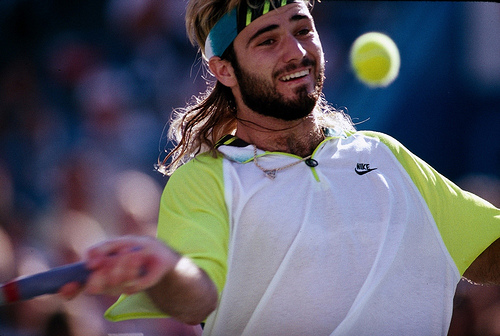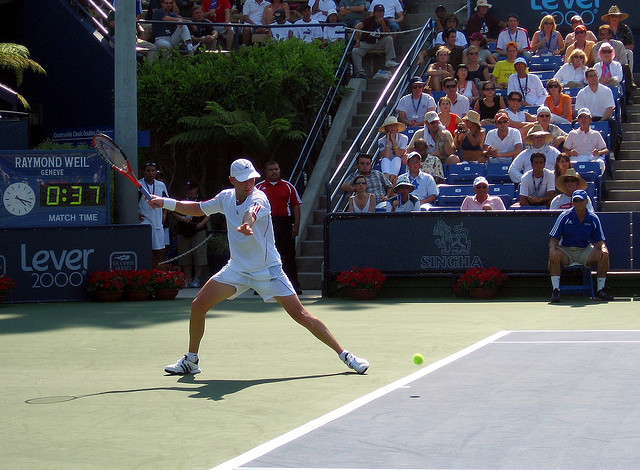Players around the world celebrate the legacy of the Andre Agassi forehand as the hallmark of the beginning of the modern tennis forehand. Agassi’s forehand is known for it’s remarkable ability to generate pace and utilize an aggressive baseline attacking mentality.
Not only did the Agassi forehand dominate the world of professional tennis with pinpoint accuracy, but it was a shot that was used to take shots on the rise. This on the rise play marked the beginning of the modern tennis forehand and what was soon to become in the evolution of power tennis players.
Achievements Of The Agassi Forehand


The Andre Agassi forehand is one of the most devastating shots of all time in tennis. He has used it to help him become one of the greatest ever to play the game of tennis. He is one of only seven men to ever win a career grand slam. Of these players, he is also the first of only two players who also have an Olympic gold medal in singles (Rafael Nadal is the other). Incidentally, Agassi is married to the only woman who has completed the career golden grand slam, Steffi Graf. Aside from the major titles, Agassi has 60 career titles and been ranked number one several times in his career that spanned from 1986 at the age of 16 to 2006.
Coached by the legendary Nick Bollettieri when he became a teenager, Agassi developed his talent for taking the ball early and putting maximum power and penetration into his groundstrokes. The forehand is one of the results of his precocious development under Bollettieri’s tutelage. In his career, he would earn the nickname “The Punisher.”
There are no mysteries or secrets to the Andre Agassi forehand. Probably the only supernatural thing was that he is blessed with tremendous hand-eye coordination and balance. This automatically gives him the three basic elements that make any groundstroke effective: early preparation (because he sees the ball early and anticipates it well), timing and transfer of weight into the shot (because he is balanced and in the right position with his feet).
Andre Agassi Forehand Grip
Agassi uses a grip that is between an eastern and semi-western grip, though it is probably closer to a semi-western. Roger Federer uses a similar grip but is a little closer to eastern. He is usually close to the baseline or even inside it during rallies, in the proper ready position – with feet apart, knees bent, torso a little forward and racket in front of his body. His clear eyesight and quick reaction time enables him to pick up on kind of incoming ball the moment after it leaves his opponent’s racket. He is very much focused on the ball and only the ball.
Agassi Forehand Preparation


Because he has seen very early what kind of shot he needs to hit, his split step is also done very early. After the split step, the circular backswing commences. Holding the racket with his right hand, he uses his left hand to help push the racket up and back. It goes in a circular path, but it is not an exaggerated loop. In fact, his whole backswing is considered to be compact. Of course, it also depends on the kind of ball that is coming his way. A fast incoming ball necessitates an even more compact swing.
The height of the shot also determines how high or low he takes his racket back. He always remains at the same level as the ball, using his whole body to adjust. Another thing he considers is the type of shot he plans to hit. Agassi usually hits the ball flat with a bit of topspin. He doesn’t usually hit loopy topspin balls, but he can. If he wants to put more spin, he will drop the racket head below the level of the ball more and then brush up and through. But usually, he really goes through the ball. Meanwhile, his left hand has let go of the racket. It starts to extend out in the direction of the incoming ball.
Andre Agassi Forehand Backswing
Because Agassi’s forehand is blessed with great coordination, his timing is absolutely fantastic. With the ball fast approaching, he is now going to do his forward swing. At the end of the backswing and the beginning of the forward swing, his elbow stays low and close to his body. The wrist is fully laid back, keeping the racket head cocked back. As his arm moves forward to meet the ball, the racket head only catches up to the ball moments before impact. The movement of the wrist through and up over the ball gives it the speed and topspin.
Andre Agassi extends forwards in the direction of the ball as his elbow comes up to level with the left shoulder. The racket head finishes over the left shoulder according to what kind of shot he has hit. If he hit his usual flat shot, the follow through is more level with the left shoulder. He does not use the windshield wiper follow through.
Footwork & Balance in the Agassi Forehand
The Andre Agassi forehand is a well-balanced shot, as previously mentioned. He uses a good wide base that makes it easy to shift into any position he needs to comfortably play this shot. This means that he can hit off an open stance, semi-open stance or a closed stance. The first two stances are the ones he most commonly uses, because it allows him to hit aggressive shots even when he has little time to react to the ball. This happens a lot for him due to his position on court which is usually very close or even inside the baseline. Because he is properly balanced, the weight transfer can be achieved with any of these stances.
Use of the Open Stance in the Agassi Forehand


Traditionally, it has been thought that only the closed stance allowed the proper transfer of weight into the shot, and for some players, this is true. Maybe those other players don’t have the sense of balance and good early preparation that Agassi has.
With an open stance, Agassi still has his left foot slightly in front because the weight is on his right foot as he takes the racket back and turns his shoulders. As he uncoils, the weight on his right foot transfers to his left foot which steps forward into the shot. On a more closed stance, the weight transfer is the same, but he also uncoils from the feet up. The weight transfers from the right foot to the left foot as he jumps into the shot. He’ll actually finish with his right foot in front and almost parallel to the net, as if preparing for a backhand. The recovery motion of the Andre Agassi forehand consists of an extra step after the shot. It is like a skipping motion of the feet after he has finished his stroke. In essence, he is again doing a split step to the neutral waiting position. The upper body also recovers to the neutral position and the racket goes back in front of the body. The head remains fixed straight ahead, focusing.
Key Points of the Agassi Forehand
The advantage of this motion is that it is less difficult to time, especially when you factor in things like the wind affecting the ball toss or something like that. The right shoulder drops below the level of the left, as with any good server, as he readies to launch up to the ball. Overall, his shoulders don’t rotate as much as Sampras, again because of the limitation in overall torso rotation discussed above.
Any student of the game should love to learn how to hit the Andre Agassi forehand. Even if they’re not blessed with his eyesight, coordination and sense of balance, they can still learn a few things from this shot. The first is the proper stance when waiting for the ball. Use a wide base, with the feet at least shoulder width apart. The next thing to remember is to focus on the ball. Even if your eyes aren’t as sharp and your hands aren’t as fast as Agassi’s, if you focus on the ball, you will have a far better chance of executing a good shot. The next is early preparation. This can actually be practiced through some drills.
Watch the ball as it comes off the opponent’s racket and tell yourself to make a backswing immediately. As the backswing commences, the ball is already travelling quickly toward you so do not hesitate on your motion. It should be one smooth continuous motion. It is also very important to keep the arm loose and relaxed. Timing comes naturally for Andre, but there are ways for regular players to learn good timing. Constant practice will also, of course, improve your timing. The follow through and weight transfer into the shot are also two things that should never be forgotten. And lastly, keep your feet moving as you make your recovery into the ready position.
With all this in mind, you will be ready to start punishing the ball with your own version of the Andre Agassi forehand.
Learn to Hit a Forehand Like Roger Federer
If you want to jumpstart your forehand and play like the PROS, check out my 70+ page Tennis Ebook that will immediately show you how you can take your forehand to the next level.
The Modern Forehand Domination Ebook is guaranteed to improve your tennis technique, and increase power, topspin and accuracy of your tennis forehand!
Modern Tennis Forehand Ebook
Learn How to Hit a Forehand Like Federer, Nadal and Djokovic

